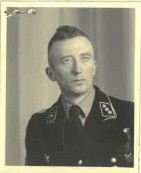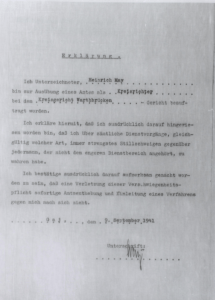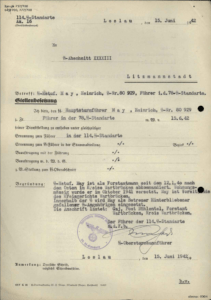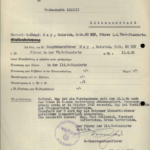Introduction to Heinrich May
Heinrich May served as the head of the forestry office in Warthbrücken (now Koło) within the Warthegau region, which included overseeing operations at the Kulmhof Forestry. Between 1941 and 1944, May bore witness to the atrocities committed at the Kulmhof (Chełmno) extermination camp. He collaborated with the SS and police Sonderkommando, facilitated their activities by supplying firewood for body disposal and implementing camouflage tactics on-site.
In early 1945, May composed a detailed report detailing his experiences in the Warthegau, which included a thorough narrative of the occurrences at the Kulmhof extermination camp. Seizing this opportunity, he aimed to disassociate himself from the atrocities, articulate his discontent with Nazi Germany, and to settle scores with the regime.
Facts Sheet
Name: Heinrich May
Birth: 28.11.1896 in Misselberg
Death:
Function: Forester Warthbrücken / Kolo (1940 – 1944)
Agency:
Rank: SS-H’stuf.
Memberships: NSDAP (21.09.1926 #44185), SS (01.01.1933 #80929)
Awards:
Education: Elementary school
Profession: Forester
Family: married, 4 children

BArch R 9361-I/56411
Curriculum Vitae
Heinrich May, born on November 28, 1896, was the son of Karl May (born December 15, 1866, died July 1, 1926), a farmer, and Wilhelmina May (born October 21, 1871, died December 28, 1940). He had 2 siblings, entered into marriage and fathered 4 children, with 2 passing away on March 24, 1920, and July 15, 1925.
He attended elementary school from 1902 to 1910. Subsequently, from 1910 to 1911, May worked in forestry and agriculture. From 1914 to 1918, he served as a volunteer on the Western Front in World War 1, where he sustained injuries.
Transitioning to civilian life, on January 1, 1918, May assumed the role of the district forestry office in Singhofen, later advancing to Oberförster on October 1, 1927, overseeing the forestry in Müngersbach (Forstamt Hachenburg). Starting from August 28, 1939, May served as Feldwebel of Infanterieregiment 463. In January 1940, he was deployed to Warthegau, managing the forestry office in Warthbrücken, encompassing approximately 51,000 ha of state-owned forests and 2,000 ha of privately owned forests.
On March 28, 1923, he joined the Völkische Bewegung (Deutsch-Sozialistische Partei), assuming a leadership role by April 1924. On September 21, 1926, May joined the NSDAP (Nazi Party) and established the local group Singhoffen near Nassau/Lahn, serving as the Ortsgruppenleiter until the Nazi takeover. Post-takeover, he transitioned into an SS leadership role, attaining the rank of SS-Hauptsturmführer. May actively participated in Wehrmacht military exercises as a reserve lieutenant.
In 1941, Heinrich May was appointed chairman of the district court in Warthbrücken (see document 1). On March 15, 1942, he was transferred as an SS leader from the 78. SS-Standarte to the 114. SS-Standarte, where May assumed the role of caretaker for surviving family members of fallen SS members (see document 2).
In late January 1945, May was dispatched to the Montabaur forestry office, through the Reichs Forestry in Berlin and the regional forestry in Wiesbaden. He authored a comprehensive report on his experience in the Warthegau, typed by his daughter-in-law, which was subsequently transmitted to the French authorities in Montabaur. The report provides a detailed account of the events that took place at the Kulmhof extermination camp between 1941 – 1944.
Sources
Documents 1 & 2


Document 1
Transcription
Erklärung
Ich Unterzeichneter, Heinrich May, bin zur Ausübung eines Amtes als Kreisrichter bei dem Kreisgericht Warthbrücken Gericht beauftragt worden.
Ich erklärte hiermit , daß ich ausdrücklich darauf hingewiesen worden bin, daß ich über sämtliche Dienstvorgänge, gleichgültig welcher Art, immer strengstes Stillschweigen gegenüber jedermann, der nicht dem engeren Dienstbereich angehört, zu wahren habe.
Ich bestätige ausdrücklich darauf aufmerksam gemacht worden zu sein, daß eine Verletzung dieser Verschwiegenheitspflicht sofortige Amtsenthebung und Einleitung eines Verfahrens gegen mich nach sich zieht.
Gaj, den 9. September 1941
Unterschrift:
[May]
Translation
Declaration
I, the undersigned Heinrich May, have been appointed to serve as a district judge at the Warthbrücken District Court.
I hereby declare that I have been expressly informed that I must maintain strict confidentiality regarding all official matters, regardless of their nature, towards anyone who is not within the immediate scope of duty.
I expressly confirm that I have been made aware that a breach of this obligation of confidentiality will result in immediate removal from office and the initiation of proceedings against me.
Gaj, September 9, 1941
Signature:
[May]
BArch R 9361-I/56411
Document 2
Transcription
114. SS-Standarte
[…]
Leslau, den 15. Juni 1942
An SS-Abschnitt XXXXIII Litzmannstadt
[…]
SS-HStuf. May ist als Forstamtmann seit dem 12.1940 nach dem Osten im Kreise Warthbrücken abkommandiert. Wohnungsmässig wurde im Jahre 1941 versetzt. May ist Vorsitzender des Kreisgerichts Warthbrücken. Innerhalb der SS wird May als Betreuer Hinterbliebener gefallener SS-Angehörigen eingesetzt. Die Anschrift lautet: Gaj, Post Mühlental, Forstamt, Warthbrücken, Kreis Warthbrücken.
Translation
114. SS-Standarte
Leslau, June 15, 1942
To SS-Abschnitt XXXXIII Litzmannstadt
SS-Hauptsturmführer May has been seconded to the East in the district of Warthbrücken since December 1940 as a forestry administrator. He was transferred in terms of housing in 1941. May is the chairman of the Warthbrücken District Court. Within the SS, May is deployed as a supervisor for the dependents of fallen SS members. The address is: Gaj, Post Mühlental, Forestry Office, Warthbrücken, Warthbrücken District.
IPN GK 757-700



